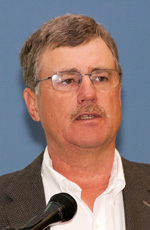General Session I
The Role of Genetic Evaluation Technology in Enhancing Global Competitiveness: An AI Industry Perspective
BOZEMAN, Mont. (June 2, 2011) — “If you want to develop a market, you have to visit your customer, get to know them,” said Willie Altenburg, associate vice president-beef marketing, Genex Cooperative Inc., Shawano, Wis.

A former Beef Improvement Federation (BIF) president, Altenburg has traveled the globe to become acquainted with prospective customers worldwide. Attendees of BIF's Annual Research Symposium soaked in the knowledge he has gained from visits to the world’s largest beef-producing countries outside the United States: Brazil, Australia, Argentina and Canada. Each country’s unique industry and resources give way to different needs regarding artificial insemination (AI).
With 54 million beef cows, Brazil is the world’s biggest player. The large country is home to nearly twice as many beef cows as is the United States.
“Because of good synchronization programs and low labor costs, Brazil is able to artificially inseminate a lot of cattle,” Altenburg said. Brazilian cattle producers AI a greater percentage of their cows than U.S. producers do.
Although many producers raise Angus, Red Angus and other breeds familiar to U.S. producers, Nelore is the most popular breed. White in color and similar in appearance to a Brahman, the Nelore is “part Brahman, part wild animal,” Altenburg joked. The cattle are extremely hardy, especially in the Amazon region, where British breeds don’t fare well.
“There is a lot of AIing to British bulls, because those bulls can’t handle the living conditions,” Altenburg explained. The Brazilians use Angus genetics as a terminal cross to add meat eating quality.
Argentina, with more than 13 million beef cows is not an export-focused country, Altenburg said. “They are a huge ‘in country’ beef-consuming country.” They also focus more on visual appearance than expected progeny differences (EPDs) when choosing semen. “Their cattle herd hasn’t suffered; they’ve done a lot with the eye. They’ve got some great-looking cattle.”
Australia is now competing with the United States for the world genetics market. Altenburg said the Australians have seen challenges in the transfer of data when exporting semen and bulls to the United States. They are now developing markets in South America for their genetics, most of which originated in the United States.
Canada’s commercial breeders are well-educated; some are even more knowledgeable about EPDs than the purebred breeders, Altenburg said. They raise big, stout cattle, so their focus is less on birth weight and more on growth EPDs.
While cow numbers in the United States continue to decline, use of AI has not, Altenburg said. The cattle states in the upper Midwest are the biggest users of beef cattle semen, and, as a percentage, first-calf heifers are far more likely to be AIed than cows. “Cow numbers have gone down, but custom collection is up and semen selection is up. Our technicians are sure more busy. We are improving our synchronization programs, so we’re seeing more and more cows being AIed,” he said.
Altenburg suggested that a global standard for EPD data might be useful in assisting with the transfer of information from country to country. While one country will accept and incorporate proven EPDs from a particular animal into their home data system, other countries are not reciprocating, which means that a bull will have to “earn his stripes” a second time around, with another series of progeny testing. This is an inefficient use of a cattle producer’s most precious commodity: time, he said.
To listen to this presentation and to view the PowerPoint that accompanied it, visit the Newsroom at www.BIFconference.com.
BIF’s 43rd Annual Research Symposium and Annual Meeting was hosted June 1-4 on campus at Montana State University, Bozeman, Mont.
Editor’s Note: This summary was written under contract or by staff of Angus Productions Inc. (API). Through an agreement with the Beef Improvement Federation, we are encouraging reprinting of the articles to those who will adhere to the reprint guidelines available on this site. Please review those guidelines or contact Shauna Rose Hermel, editor, at 816-383-5270. PowerPoints are posted with permission of the presenter and may not be reproduced in whole or in part without the express permission of the presenter.
API's coverage of the event is made possible through collaboration with BIF and sponsorship by BioZyme Inc. through its significant gift to the Angus Foundation. For questions about this site, or to notify us of broken links, click here.
Headquartered in Saint Joseph, Mo., API publishes the Angus Journal, the Angus Beef Bulletin, the Angus Beef Bulletin EXTRA, and the Angus e-List, as well as providing online coverage of events and topics pertinent to cattlemen through the API Virtual Library.



